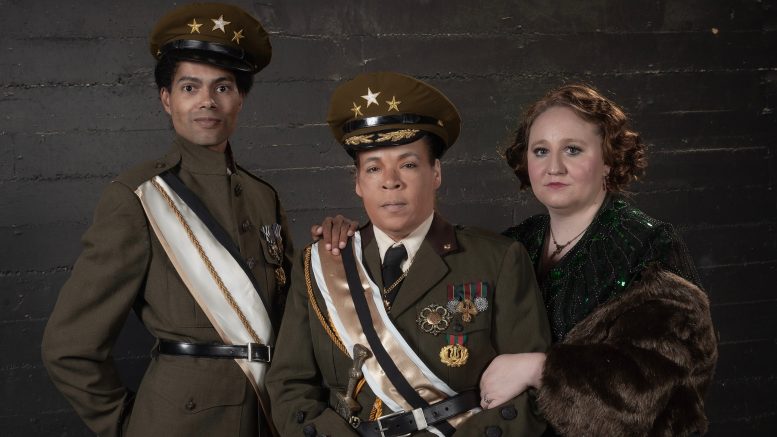By Dave Kempa
The flash of paparazzi cameras. The flash of lightning. The flash of a knife.
In “Julius Caesar 1922,” the Sacramento Shakespeare Festival overlays The Bard’s great tragedy about the end of the Roman republic to a visual backdrop of 20th-century Italy — the cusp of Benito Mussolini’s march on Rome and rise to the fascist state — in a pleasing manner that blends two seismic historic events that took place in the very same city some 2,000 years apart.
For over a decade, I’ve enjoyed the summer production put on by Sacramento City College’s City Theatre. And while it is a bit disappointing to no longer enjoy a Shakespeare play over wine and cheese as the sun sets beyond the William A. Carroll Amphitheatre, the troupe this year does not disappoint; Art Court Theatre’s air conditioning also makes up for the lack of wine — but bring an extra layer!.
The players make use of an open, barebones stage — optimal for the chaos of sword fights and disorienting battles — laid out before a simple backdrop painted the colors of the Italian flag in green, red and white. On the ground in front of the stage, jarringly, is the symbol for Mussolini’s fascist Blackshirts militia.
Sarah Palmero portrays Julius Caesar with the lofty air of a war hero turned formidable populist just before his great fall. “Rome’s senatorial conspirators, led by a slinking but smooth Caius Cassius (Phoenix A. Brewer) and the reluctant, ever-brooding Marcus Brutus (Matthew Fairall), are increasingly convinced that Caesar’s rise to dictator perpetuo (dictator in perpetuity) will mean the end of the great Senate.
One of the most pleasant quirks in this production is the use of the soothsayers (Joy Hall Gee, Katherine Folsom and Luna Solis) — who famously warn Caesar with the ominous maxim “Beware the ides of March” — as ushers to death, chaperoning deceased characters off the stage.
Despite the soothsayers’ warning and his wife Calpurnia’s (Julianna C. Schultz/Janey Pintar) attempts to keep him home on March 15, Caesar is drawn out to the Senate by the conspirators.
We all know how that story ends, which is why Shakespeare places Caesar’s assassination in the first half of the play. Kudos are in order for the delivery of this iconic scene; viewers find themselves leaning toward the edge of their seats as knives emerge and senators clad in 1920s gangster suits converge around the fated leader. Onlooking actors place themselves beside the audience to heighten the moment with their dismayed shouts and sharp cries of disbelief as the violence breaks — to great effect.
The second most anticipated moment in any Julius Caesar production is the stirring monologue delivered at Caesar’s funeral by his friend Mark Antony. Actor Jonathan Plon just nails it. Chin up and jaw jutted in a manner reminiscent of an old Mussolini photo, Plon takes Mark Antony’s emotional oscillations between grief and vengeance, as well as the disdainful sarcasm in repeatedly mentioning Caesar’s confidant-turned-killer, Brutus, as an “honorable man,” convincingly turning the people of Rome against their fallen leader’s assassins.
Thus the war begins in the second half of the play, as Brutus and Cassius flee to build and prepare their own armies against Mark Antony and Caesar’s heir, Octavius Caesar (Matthew Mallone).
I walked into the college theater production with the understanding that the players probably weren’t heavily trained in the art of stage violence and stunts. That said, the battle scenes come in waves of utter chaos — I mean this in the best way — that overwhelm the senses. One could come to this production three times, view it from three different walls, and notice countless things they’d missed the night before.
I am an absolute sucker for Shakespeare with a twist, be it a comedic retelling set in the disco era, or a classic ancient Roman tragedy thrust into the tumult of the rising specter of fascism. And while the character storylines may not overlay to perfection, Julius Caesar set in Mussolini’s Rome is fitting. Major credit goes to costume designer Nicole Sivell on that front; from the imposing Blackshirts to the cosa nostra stylings of the suits donned by the senators, the flair of the wardrobe makes up for the stage’s purposeful minimalism.
When July rolls around, many local patrons of the arts dutifully get their Sacramento Shakespeare Festival tickets to see what crazy concept they’ve got cooking this year. It’s tradition.
The fascist-era depiction of the fall of the 500-year Roman republic doesn’t pack in the same laughs as their previous summer comedies, but it’s a captivating theater experience with compelling reflections of the past century.
This story was funded by the City of Sacramento’s Arts and Creative Economy Journalism Grant to Solving Sacramento. Following our journalism code of ethics and protocols, the city had no editorial influence over this story and no city official reviewed this story before it was published. Our partners include California Groundbreakers, Capital Public Radio, Outword, Russian America Media, Sacramento Business Journal, Sacramento News & Review, Sacramento Observer and Univision 19.


Be the first to comment on " ‘Julius Caesar 1922’ brings a 20th century twist to a classic tale in Sacramento"